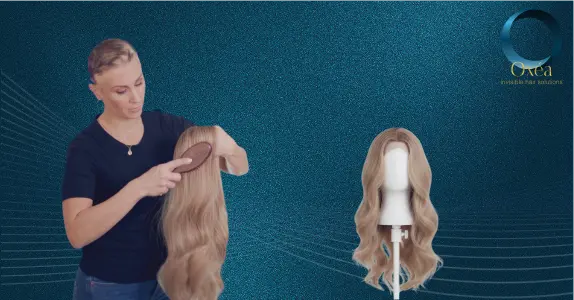Black Friday Offer – Receive 25% off on your new hair system! Claim Your Offer




Contact our specialists now for Hair Replacement!
Wig care is not just about giving it a proper wash, but it’s the difference between a piece that lasts a few weeks and one that serves you beautifully for months.
After years of perfecting wigs, we have seen the mistakes that cost people a lot, and on that basis, we can tell you that proper wig maintenance starts with education, not expensive products.
Wigs behave according to their construction and fibre type; ignore these fundamentals, and you’re setting yourself up for frustration. Master them, and you’ll wonder why everyone else struggles whilst your wig consistently looks great. Prevention beats correction every single time!
Because if you’re going to wear it, you might as well own it.
Each wig type comes with its own maintenance demands, styling potential, and lifespan. So, before you commit, know your categories inside out.
These are the most accessible and low-maintenance options. The fibres are pre-styled, meaning what you see is what you get. They hold their shape brilliantly but don’t cope well with heat unless labelled as heat-resistant. Think convenience, not versatility.
The gold standard. Natural, durable, and versatile, these wigs behave just like natural hair because they are natural hair.
They can be coloured, styled, curled, blow-dried, but with that flexibility comes greater responsibility. You’ll need to invest in proper wig care tips to keep it soft, nourished and wearable for long term. The wig’s lifespan here can stretch months, but only if you treat it right.
| Quick expert note: The wig’s construction matters too, lace front, full lace, monofilament caps, all affect how natural the hairline appears and how breathable or secure the unit feels on your scalp. For those with sensitive scalps or undergoing hair loss treatments, these construction choices are very important.
And if you’re looking for textured units that cater to coarser curl patterns? Our speciality lies in creating Afro hair wigs that don’t compromise on density, definition, or comfort.
Professional wig fitting begins with understanding cap construction. Monofilament provide the most natural scalp appearance, whilst lace fronts offer smooth hairline integration.
Machine-made wefts are more durable but less breathable than hand-tied alternatives( so keep this in mind)!
Wig density ranges from 80% (light) to 180% (extra heavy), with 120-130% representing average human hair density. Length affects both styling options and maintenance requirements, longer pieces require more careful handling and storage.
A flat wig looks lifeless. A too-thick one? Unnatural. Choose a density that matches your head shape and personal style. Texture matters too straight, wavy, curly or coily. And if you’re after authenticity with curl pattern, our Afro hair wigs offer natural density, texture and structure that celebrates natural beauty.
From a clinical perspective, synthetic wigs are brilliant for low manipulation. If your scalp is undergoing healing or inflammation, less styling = less stress.
But if you need styling freedom (particularly for long-term wearers), opt for human hair wigs. It retains the cuticle, meaning fewer tangles, longer wear, and more adaptability.
Not all human hair is equal, so always ask about origin, processing, and cuticle alignment. We use ethically sourced, high-density strands with natural flow.
Matching your natural texture requires understanding hair patterns across the entire spectrum from pin-straight (1A) through loose waves (2A-2C), defined curls (3A-3C), to tight coils (4A-4C).
Each texture category behaves differently, requires specific care, and responds uniquely to environmental factors like humidity and heat. Getting this wrong means your wig will never look natural, regardless of how much you spend.
The complexity increases with mixed textures. Many people have varying curl patterns throughout their head, making perfect matching nearly impossible without professional guidance.
At Oxea London, our particular expertise in crafting wigs means we understand the requirements of highly textured hair, where curl pattern consistency and natural movement are important.
Colour selection extends far beyond simple shade matching. Base colour, undertones, highlights, lowlights, and root shadows all contribute to a natural appearance. Professional colour consultation ensures your investment complements your skin tone, lifestyle, and maintenance preferences.
If you’re using wigs daily as a hair loss solution, weight, cap fit, and fibre friction must be considered.
Longer wigs add tension to already sensitive areas, especially around the nape and temples. We often recommend shoulder-length units with layered ends to reduce heaviness while still giving coverage.
For active clients or those recovering from scalp treatment, look for lightweight units with adjustable elastic bands( without glue).
| Pro tip: A well-selected wig should feel like you, not like you’re wearing someone else’s hair.
Before you think of washing your wig, there’s groundwork to be done because improper preparation can shorten your wig’s lifespan.
Think of this stage as preventative maintenance: it stops matting, protects fibres, and ensures that your wash routine improves the wig instead of wearing it down.
Always detangle a wig using a wide-tooth comb or wig-specific detangling brush. Start from the ends and work upwards to avoid tugging and snapping fibres.
Never detangle a women’s wig while it’s wet; it stresses the strands, especially at the wefts.
| Expert insight: For curly textures, particularly 3C to 4C types – finger detangling preserves curl pattern better than tools. This also prevents over-stretching the hair, which leads to fibre fatigue over time.
Placing the wig flat in your sink is a mistake.
Use a wig head or stand to keep the shape intact and give you full control over the direction of washing. It’s not just about ease it prevents unnecessary tangling and protects the lace.
Focus on areas where oils or adhesive residue build up, typically the lace front, crown, and nape.
These need to be gently pre-cleansed using a wig-safe sulphate-free cleanser or micellar water. For Afro hair wigs, be especially careful around the hairline, where edge control products tend to accumulate.
You’ll need:
Optional: knot sealer spray (for lace units), if you want to prolong the lifespan.
Fill a basin or sink with cool/lukewarm water and add a capful of wig shampoo.
Turn the wig inside out and gently submerge, letting the water penetrate the cap and fibres.
Don’t swirl or twist. This causes tangling, especially at the nape and crown, where hair density is highest.
Use your fingertips to lightly massage the lace front, parting, and areas where sweat or product tends to collect.
For curly hair wigs, be especially careful with coiled textures. Use downward motions to maintain the curl pattern.
Rinse under cool running water in the direction the hair falls – root to tip. This reduces tangling and helps remove product fully. Do not scrub or squeeze the hair; instead, allow water to run through naturally.
This step determines how your wig feels, behaves, and wears in the days to come. Do it wrong, and you’re left with frizz, roughness or heavy strands. Do it right, and your wig stays soft, lightweight and beautiful.
Use a lightweight, wig-safe conditioner. Avoid the roots or knots. Conditioner softens knots and weakens them over time, causing shedding. Apply from mid-shaft to ends only.
Leave the conditioner on for 5–10 minutes max. Any longer and you risk residue buildup, especially with synthetic wigs.
Rinse again in the direction of the hair. Never upside-down, never back-to-front.
Once done, gently blot (not rub) the wig with a microfibre towel. Avoid terry cloths, they’re too rough and can snag fibres, particularly on delicate lace units.
Place the wig on a wig stand or mannequin head. Avoid direct sunlight, and never use a hairdryer unless the wig is heat-safe and you’re using a protective serum.
| Pro insight: Want to retain shape? Place a hair net over the wig as it air-dries. This maintains curl definition or wave pattern without stiffening sprays.
Once dry, a light spritz of leave-in conditioner or knot sealer (for human hair lace wigs) helps lock in moisture and prevent shedding. You’ll feel and see the difference with every wear.
When you want your wig to look natural and stay in place all day, styling matters.
Remember, less is always more with wig styling products. A single pump of serum distributed through lengths from 12 inches to 24 inches will suffice for most styling needs.
| Tips for wearing wigs properly include minimal direct heat, using heat protectants (for human hair), and matching density to style so it moves naturally.
Want to know how to care for a wig like a true expert? It starts with consistent, small habits. Daily wig care prevents irreversible damage, especially around the lace, parting, and high-friction areas like the nape.
The best way to wash a synthetic wig is to use cool water and a wig-specific shampoo or a gentle shampoo. Gently swish the wig in the water, let it soak for a few minutes, then rinse thoroughly. Avoid twisting the wig.
There are various methods to keep your wig secure, including using a wig cap, wig clips, or speciality adhesives. To learn about all of the options, including wig tapes, glues, you can read the full blog post here.
To keep your wig from tangling, regularly brush it gently with a wide-tooth comb or wig brush, starting from the ends and working your way up. It’s also helpful to store it on a wig stand when you’re not wearing it.
In terms of the unit’s lifespan, a bonded system lasts longer (6-7months). A clip-on unit may need replacing sooner (3-5 months) due to wear on the clips, but it is designed for daily removal.
To dry a wig quickly without heat, gently blot it with a microfiber towel to remove excess water, then place it on a wig stand and use a fan to circulate cool air around it.
A well-cared-for wig lasts longer, looks better, and feels like it’s truly yours.
At Oxea London, we bring expertise to every detail, from density and texture to guiding you towards storage and styling. If you’re ready to get the fit and feel just right, book a free consultation now!
Megan Brooks is a Certified Trichologist at Oxea Invisible Hair Solutions with over 21 years of Unbeatable experience. Throughout her remarkable career, she has successfully completed an impressive 8000+ hair replacement systems. Megan is dedicated to transforming lives and boosting self-confidence so that one can live with all the pride. She has served over 800 satisfied clients and still-counting, while helping them regain their natural appearance and feel their best.

Please choose your preferred location to continue …